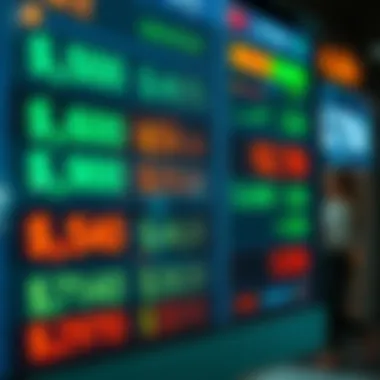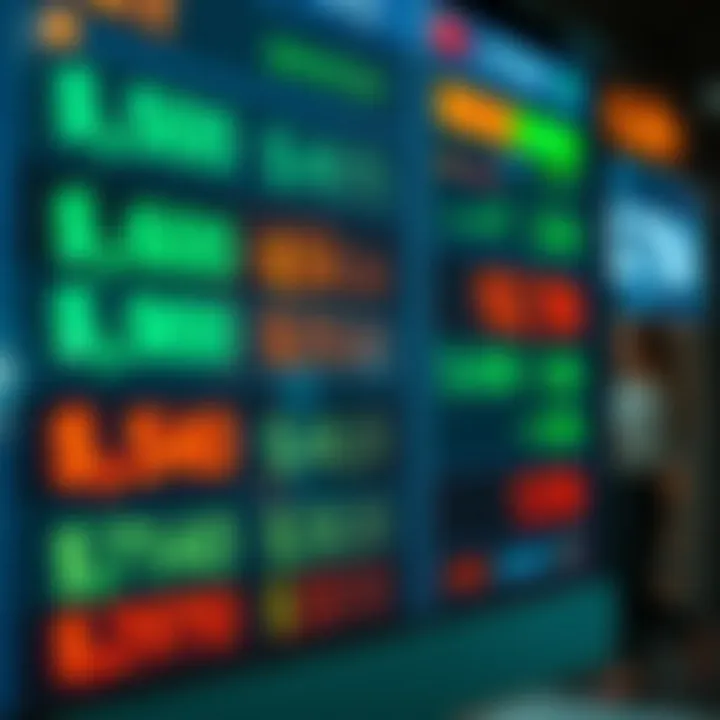Converting 3500 Dollars to AED: Currency Exchange Insights


Intro
In an increasingly globalized world, understanding currency exchange dynamics is crucial, especially for those involved in investments or overseas transactions. The conversion of 3500 dollars into United Arab Emirates Dirhams (AED) is a task many face, whether it’s for relocation, business, or investment purposes. This article dives into the intricacies of currency exchange—what influences rates, current market behaviors, and the future landscape regarding currency conversions.
Diving deeper, this discussion is particularly relevant for investors and expatriates eyeing the Dubai real estate market. Grasping the relationship between currency variations and investment potential is essential to make informed financial moves. With many factors at play, from global economic shifts to local policies, having a solid foundation in these dynamics can spell the difference between a flourishing investment and a costly mistake.
Before we link the practicalities of conversion to broader market trends, first, it’s essential to understand the current nuances surrounding currency rates and how they position investors in a fast-paced environment.
Market Trends
Current Market Analysis
As of now, the exchange rate for converting dollars to AED is shaped by various economic indicators, including inflation rates, interest rates, and geopolitical stability. The 1 USD to AED exchange rate usually hovers around a stable point of approximately 3.67, although fluctuations can occur based on market sentiment or economic developments.
Recent reports have indicated a slight weakening of the dollar against the Dirham, driven by higher oil prices which have strengthened the UAE’s economy overall. The correlation here is straightforward: a stronger UAE economy generates confidence in the dirham, thereby influencing the exchange value.
For expatriates and investors, knowing when to convert currency can lead to significant savings, especially when larger sums are involved. For example, converting at the right moment can either put more AED in your pocket or lead to missed opportunities.
Future Projections
Predicting future currency behaviors is akin to gazing into a crystal ball. However, some prevailing trends merit attention. Analysts suggest that as global economies recover from recent downturns, the value of the dirham may stabilize or strengthen against the dollar. Additionally, upcoming events such as UAE’s Expo 2020 and a surge in tourism could amplify demand for AED, particularly in the local real estate market.
Understanding these dynamics gives potential investors an edge. Being astute and monitoring exchange trends over time can help in deciding when to engage in currency trading or buy into real estate ventures.
Investment Opportunities
High-Growth Areas
Navigating the current investment landscape in Dubai, it is vital to identify high-growth areas. Neighborhoods such as Dubai Marina, Downtown Dubai, and Jumeirah Village Circle are noteworthy. Investments here are often seen as safe bets due to their enduring demand and potential for value appreciation.
- Dubai Marina: Known for its luxury high-rises and vibrant lifestyle, properties here attract tenants willing to pay a premium.
- Downtown Dubai: Home to iconic structures like the Burj Khalifa, this area remains a magnet for both investors and tourists alike.
- Jumeirah Village Circle: A more affordable option that shows potential for development and growth, appealing increasingly to investors looking for value.
Key Investment Strategies
For investors looking to make the most of converting dollars to AED, a sound strategy is essential. Here are a few crucial approaches:
- Timing: Keep an eye on market trends. Converting your dollars during favorable rates can maximize your Dirhams.
- Diversification: Don't put all your eggs in one basket. Spread investments across various areas or property types to mitigate risk.
- Research: Knowledge is power. Understand the local regulations and market demands to make informed decisions regarding real estate investments.
"Understanding currency dynamics offers a leg up for anyone looking to make strategic financial moves in a volatile market."
For further insights into currency exchange and real estate strategies, check resources like Investopedia, Dubai Land Department, or Qatar University for additional research and data.
Prologue to Currency Conversion
Currency conversion isn't just about swapping one type of money for another. It's a lens through which you can view the broader picture of global economics. Understanding how currency exchange works is vital for anyone planning to travel, invest, or conduct business internationally.
The Importance of Currency Exchange
In today’s interconnected world, currency exchange rates can have a profound impact on financial decisions. For expats considering a move to the UAE, or investors eyeing properties in Dubai, knowledge of currency dynamics helps mitigate risks and enhance financial returns. Factors like supply and demand, inflation rates, and even geopolitical trends can influence these rates. Therefore, being clued up on how exchange rates fluctuate can save you from unnecessary losses and help navigate the financial landscape more effectively.
Furthermore, awareness of currency exchange can lead to better budgeting. Knowing how much your dollar will fetch in AED can impact vacation plans, living costs, and investment strategies. A small adjustment in rates can translate into significant differences in expenses or revenue; thus, it’s crucial to stay informed.
Overview of Dollar to AED Exchange Rate


The exchange rate between the US dollar and the UAE Dirham is often pegged, meaning the Dirham's value is fixed to the dollar at a defined rate. As of the latest updates, 1 US dollar typically converts to around 3.67 AED. However, this can vary slightly due to market conditions and bank fees, which are often hidden until the transaction happens.
When translating dollar amounts to AED, understanding this fixed peg is important. It simplifies conversions and offers a sense of price stability. However, while the peg offers predictability, dollar fluctuations can still adjust living costs or investment returns in the UAE. Be it for a holiday fund or serious property investments, understanding this conversion lays the groundwork for smart financial choices.
"Understanding the subtleties of currency conversion is more than a necessity for travelers; it's a strategy for financial resilience and opportunity in a globalized economy."
With this background in mind, we can now delve deeper into current exchange rates in order to grasp more subtle and complex factors that influence currency valuations.
Current Exchange Rate Analysis
When dealing with the conversion of dollars to AED, understanding the current exchange rate is fundamental. The exchange rate directly influences the amount of dirhams one receives in return for converting an amount in dollars. It is not just a number; rather, it represents the complex interplay of economic indicators, global events, and market sentiments.
In this context, individuals and businesses must grasp the current exchange rate to optimize their financial decisions. By monitoring rate movements, a user can decide the most beneficial time to convert currency, thereby maximizing their purchase power. Additionally, fluctuations in the exchange rate can have significant implications for investor confidence and market stability, particularly in a dynamic economic landscape like Dubai.
Understanding Daily Fluctuations
Exchange rates don’t stay static; they can change by the minute due to various factors. On a daily basis, the fluctuations are often influenced by:
- Market Sentiment: Public perception regarding economic stability can cause rapid swings in currency value.
- Economic Reports: Key data releases, such as employment rates or GDP growth, play a significant role. For instance, a strong report can bolster the dollar, whereas poor data could weaken it.
- Interest Rates: When central banks adjust interest rates, they influence currency demand. Higher rates typically attract foreign capital, increasing the currency's value.
In understanding these fluctuations, one can recognize that sometimes it's a matter of just riding the waves. An investor or expatriate must keep an eye on the broader economic trends while being adaptable to sudden changes.
Sources for Real-Time Rates
To make informed decisions regarding currency conversion, having access to real-time exchange rates is crucial. Several reliable sources provide up-to-date information:
- Financial News Websites: Websites like Bloomberg or Reuters offer live updates on currency rates and market analysis.
- Currency Converter Apps: Apps such as XE Currency or OANDA not only provide real-time rates but also historical trends, which help in making comparative analyses.
- Bank Websites: Many major banks display real-time exchange rates on their web portals, allowing users to check current rates before making conversions.
It's essential to cross-verifying rates from multiple platforms to ensure accuracy, as there might be slight variances depending on the source.
"Understanding exchange rates is like pulling the strings of a finely tuned instrument. Each factor contributes to the overall sound - one misstep can lead to dissonance in your financial plans."
Keeping these aspects in mind gives individuals involved in currency conversion a clearer insight into the market dynamics at play, enabling better decisions in their transactions and investments.
Factors Influencing Currency Values
Understanding the factors that influence currency values is crucial for anyone looking to convert currencies effectively. This knowledge helps individuals, particularly investors, expatriates, and real estate buyers, navigate the often turbulent waters of currency exchange. Knowing how various external and internal elements affect currency can not only enhance financial decisions but also optimize the value received when converting dollars to AED.
Economic Indicators Impacting Exchange Rates
Economic indicators serve as reliable indicators of how a country's currency is performing on a global scale. Gross Domestic Product (GDP), employment rates, and inflation are among the key metrics that drive currency valuations. When a nation experiences strong economic growth, its currency tends to appreciate. For instance, if the GDP of the United States shows marked improvement, the dollar might strengthen against the AED. Conversely, if unemployment rises or inflation spirals, it can lead to depreciation, affecting the conversion rates unfavorably.
Some pivotal economic indicators include:
- Consumer Price Index (CPI): Measures the average changes in prices over time that consumers pay for a basket of goods and services.
- Interest Rates: Changes in interest rates directly impact currency value. A rise in interest rates might attract foreign investment, boosting demand for that currency.
- Trade Balance: A surplus indicates more exports than imports, generally raising the currency's value, while a deficit could lead to depreciation.
In the context of converting 3500 dollars to AED, one must keep an ear to the ground regarding these indicators. They can shift rapidly and may have immediate effects on the exchange rate. For more on economic indicators, you can refer to valuable sources like Investopedia.
Political Stability and Its Effect
Political stability plays a significant role in currency valuation. When a country exhibits a stable political environment, it reassures investors and traders, leading to stronger demand for its currency. Countries with ongoing political turmoil or uncertainty often see their currencies weaken due to the perceived risk.
For example, if there’s a looming election in the United States that might alter fiscal policies drastically, investors might become wary, prompting them to liquidate their dollar holdings, which could devalue the currency. The United Arab Emirates, being a relatively stable region in the Middle East, tends to draw investors looking for a safe haven to park their funds. This stability often reflects positively on the AED.


Factors that underscore political stability include:
- Government policies: Favorable trade agreements and taxation policies can boost currency strength.
- International Relations: Healthy diplomatic relations enhance investor confidence, while tensions might have the opposite effect.
- Regulatory Environment: Transparent regulatory frameworks and minimal bureaucratic hurdles attract foreign investment, positively influencing the currency.
In summary, recognizing how both economic indicators and political stability interplay with currency valuation is key for anyone converting funds for real estate investments in Dubai. Staying updated with local news, reports from financial institutions, and trend analyses can provide the edge needed to make informed decisions. Always consider checking well-regarded financial news outlets like Bloomberg for the latest insights on these factors.
Practical Steps for Currency Conversion
Currency conversion can be a perplexing task, particularly when dealing with large sums like 3500 dollars. Knowing how to convert your money efficiently can save you both time and money. In the context of our article, understanding practical steps for currency conversion is essential for expatriates, investors, and anyone interacting with the UAE's economy. This section details various methods of conversion, their respective advantages, and considerations one must keep in mind to secure the best possible rates and services.
Evaluating Conversion Methods
When it comes to converting 3500 dollars to AED, it's crucial to evaluate the different methods available. Each method has its own set of pros and cons that can influence your overall experience:
- Banks: Traditional banks are typically a reliable option. They offer security and a transparent process. However, they might not provide the most competitive rates and could charge hefty service fees.
- Bureau de Change: These exchange offices can be found in malls and tourist areas, often flaunting bright neon signs. They might offer better rates than banks but can vary widely in terms of fees, so it pays to shop around.
- Online Platforms: Digital services such as TransferWise or Revolut have made currency conversion easy and straightforward. They often provide better rates with lower fees but require you to set up an account and link your bank.
- Peer-to-Peer Exchanges: Some services connect individuals who want to exchange currency directly. This method can be beneficial if you find someone looking to swap the same amount as you.
Choosing the right method depends on your individual needs, urgency, and comfort level with technology. Don't put all your eggs in one basket; explore multiple avenues to ensure you're making a well-informed decision.
Utilizing Financial Institutions
When considering financial institutions for currency conversion, the focus should be on three pillars: transparency, reliability, and security. Most banks can facilitate currency exchange, allowing customers to convert dollars into AED with varying rates.
It's important to inquire about the exchange rate—the rate used by the institution to convert one currency to another—along with any service fees they may impose. Sometimes, a seemingly attractive rate can be negated by high fees. It’s wise to ask directly what the total cost will be for your conversion.
To maximize your experience:
- Check if your bank has partnerships with local institutions in the UAE, which might provide better rates.
- Consider the timing of your transactions; some banks adjust their rates throughout the day.
- Use your bank's online tools to monitor real-time rates before going in-person.
Overall, while banks offer security in handling large transactions, being savvy about fees can make a big difference in what you ultimately receive in AED.
Online Currency Exchange Platforms
The internet has revolutionized how we conduct currency conversions. Online platforms have grown in popularity due to their convenience and often more favorable rates. However, while engaging with these platforms, careful navigation is essential to avoid pitfalls.
Several factors should guide your choice of an online exchange service:
- Reputation: Look for platforms that have glowing reviews on independent sites like Reddit or personal finance blogs. Trust is vital when it comes to financial transactions.
- Fees: Always read the fine print. Some services might have hidden charges that could add up, overshadowing the initial attractive rates presented.
- Speed of Transactions: Depending on your needs, you may require a service that processes transactions quickly. Check if there are delays in fund transfers to your account or to the recipient.
- Customer Support: Good customer service can be a lifesaver, should any issues arise during your transaction.
A few reliable platforms to consider are Revolut and TransferWise. Both are known for their user-friendly interfaces and competitive rates, although they might cater to varying user needs and preferences.
Implications for Real Estate in Dubai
Understanding the implications of currency conversion, particularly the exchange from dollars to AED, is crucial for anyone looking to invest in Dubai’s thriving real estate market. With the UAE being a global hub for commerce and tourism, the dynamics of currency exchange can significantly shape investment opportunities. This section aims to shed light on how fluctuations in currency values—especially for expatriates and international buyers—impact overall property purchasing strategies, the value of investments, and the rental market dynamics.
Purchasing Property with Foreign Currency
When it comes to purchasing real estate in Dubai, the ability to convert dollars to AED efficiently is paramount. Investors entering this market are often faced with decisions like whether to hold onto their home currency or convert to AED immediately. A strong dollar can offer a distinct advantage. If the exchange rate is favorable, buyers effectively gain more purchasing power, enabling them to access more desirable properties or those in prime locations.
However, the process isn't without its considerations. Buyers must be aware of the existing market conditions both in the UAE and in their home country. For instance, fluctuations due to economic changes can be a double-edged sword. If the dollar depreciates while the buyer is still holding it, the eventual conversion could lead to a decrease in purchasing ability. This potential for loss is pivotal in long-term investment planning.
Investment Value of AED in Real Estate
Investing in AED has its own set of merits. For expatriates who have settled in the UAE and have regular income in AED, denominating investments in local currency can mitigate risks tied to exchange rate fluctuations. When considering the investment value of AED, one must evaluate the UAE's robust market fundamentals, including high demand for properties and a steady influx of expatriates.


Additionally, owning property in AED can lead to better integration into the local market. Investors find that interacting with local financial institutions, landlords, and service providers is smoother when transactions are conducted in the currency of the country. Investing in AED not only seals the deal when acquiring property, but it can also yield dividends down the line, as property values often advance in tandem with the UAE's economic growth.
Understanding the Rental Market in AED
The rental market in Dubai also warrants close examination when discussing currency implications. Most rental agreements are made in AED, meaning foreign investors need to keep an eye on the exchange rate to calculate their projected rental income against any dollar-based expenses.
In many expatriate-favored locations, rental yields can be quite attractive. Investors converting dollars to AED and entering the rental market can benefit, especially in high-demand areas where property values are rising.
Here are a few points to consider:
- Market Trends: Staying in tune with real estate market trends, rental demand, and vacancy rates can provide valuable insights.
- Regulatory Understanding: Familiarizing oneself with local tenancy laws is critical. Such knowledge aids in averting potential pitfalls.
- Long-Term vs. Short-Term Rentals: Different strategies have varying impacts on cash flow, which is tightly connected to the value of AED relative to other currencies.
Understanding currency dynamics is akin to navigating a ship through varying tides; one must always prepare for shifts that can change the course unexpectedly.
Case Study: Converting Dollars
When it comes to currency conversion, the practicalities surrounding a case study like converting 3500 dollars to AED can provide valuable insights. Understanding this process serves multiple purposes for various groups, like investors and expatriates.
Engaging in such a real-world example sheds light on the direct impact of market rates and possible fees involved in the transaction. From the perspective of investors, knowing how much AED one can acquire from a fixed amount in dollars can guide decision-making, particularly if real estate or other local investments are on the horizon. For expatriates, this conversion is often a daily necessity, influencing their budgeting and spending habits within the UAE.
"Currency exchange is not just about numbers; it’s about creating opportunities and understanding the market you’re entering."
Furthermore, the significance of this case study lies in its ability to mirror economic conditions. The fluctuations that accompany a transaction can highlight broader economic trends, not only in the UAE but also in the United States. Thus, converting 3500 dollars is not just a number; it's a window into the complexities of global finance.
Step-by-Step Conversion Process
Converting 3500 dollars into AED requires a careful approach. Here’s a straightforward breakdown:
- Check the Exchange Rate: Before making any move, it’s paramount to find the current exchange rate. This can fluctuate based on market conditions, so consulting a reliable source—like banks or financial websites—is crucial.
- Select Your Method of Conversion: Whether opting for a bank, an online platform, or a local exchange service, the method can impact the rate you get. Traditional banks may charge a premium, while online platforms might offer more competitive rates.
- Calculate the Amount in AED: Once you have the exchange rate, multiply your dollars by this figure. For example, if the exchange rate is 3.66 AED for every 1 dollar, then 3500 dollars would convert into approximately 12,810 AED.
- Account for Fees: Always factor in any transaction fees. Different platforms may have varying fee structures, which can subtly change the final amount you receive.
- Execute the Transaction: Once everything is in place, initiate the conversion. Ensure all details are correct to avoid any hiccups during this stage.
- Confirm and Monitor: After the transaction, confirm the new AED balance and monitor exchange rates for future conversions. This could be beneficial for future financial planning.
Effects of Conversion on Investment Plans
The conversion of 3500 dollars to AED holds specific ramifications for investment strategies. Here are some key effects:
- Investment Opportunities: Accessing AED with dollars means gaining purchasing power in markets like real estate or commercial sectors in Dubai. Investors might use this converted amount towards acquiring property or funding ventures, directly influencing their portfolios.
- Impact of Exchange Rates: Currency fluctuations can affect future investments. A favorable rate today could turn unfavorable tomorrow, impacting your financial strategies. Monitoring exchange rates becomes essential for maximizing returns.
- Budgeting for Expatriates: For expatriates residing in Dubai, understanding how their dollars translate into AED helps plan their monthly budget. This conversion might determine lifestyle choices, like housing and leisure activities.
- Investment Timing: Knowing when to convert dollars into AED can mean the difference between profitability and loss. Strategic timing can leverage favorable exchange rates and enhance investment viability.
The conversion of 3500 dollars holds profound implications for decision-making. Understanding these dynamics lays the groundwork for informed financial endeavors in the dynamic landscape of the UAE.
Epilogue
Concluding an analysis on the conversion of 3500 dollars to AED provides a critical lens on the practical and theoretical nuances of currency exchange. This process is not just a matter of simple arithmetic; it encapsulates a range of factors that investors and expatriates must consider for effective financial planning. Understanding the implications of currency dynamics can lead to wiser decisions, especially in a multifaceted market like Dubai’s real estate sector.
Summary of Key Insights
Delving into the previous sections reveals several key points that are relevant for anyone interested in currency conversion:
- Exchange Rates Fluctuate: The rate at which dollars convert to AED fluctuates daily based on various economic factors, including inflation, interest rates, and geopolitical stability. Investors must keep this in mind when planning transactions.
- Conversion Methods: Different methods for currency conversion exist, ranging from physical exchange at banks to online platforms, each with distinct fees and convenience levels.
- Market Implications: In Dubai, the valuation of the dirham significantly affects real estate investment opportunities. Knowing how currency values change can lead to smarter investment strategies.
For those looking to make financial decisions involving AED, being equipped with this knowledge is crucial. It provides the foundation needed to seize opportunities in real estate and beyond.
Future Outlook on Currency Fluctuations
Looking ahead, the landscape of currency exchange is primed for potential shifts that could affect the dollar-to-AED conversion rate. Indicators such as economic recovery post-pandemic, changing oil prices, and evolving geopolitical landscapes will all play significant roles. Investors should remain vigilant and adapt their strategies accordingly. Reports from sources like The Wall Street Journal and economic forecasts from institutions like the International Monetary Fund can be instrumental in anticipating these changes.
Staying informed about global economic trends can be the difference between a profitable investment and a missed opportunity.
The ongoing monitoring of exchange rates and understanding the underlying factors can significantly enhance an investor's capacity to navigate the often murky waters of international currency markets. By keeping an ear to the ground and a finger on the pulse of economic changes, individuals can better prepare for what lies ahead.
In summary, mastering the intricacies of converting currency is not just about numbers; it’s about recognizing the larger economic currents that define our financial strategies.







